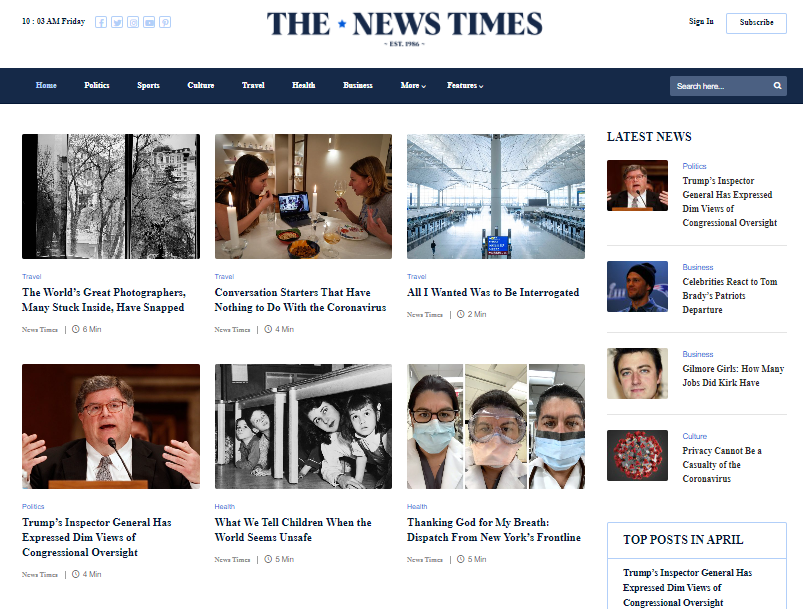How stnews.live Different in the Crowded News Market
Wiki Article
The Effect of Social Media on the Way We Eat News Online
Social media has actually essentially transformed news intake. It supplies immediate access to info, typically eclipsing conventional media outlets. However, this rapid circulation comes with obstacles. Customers face the risk of coming across false information and coming to be entraped in echo chambers. The formulas driving individualized web content can obscure varied viewpoints. As these characteristics evolve, comprehending their ramifications ends up being essential for notified engagement in public discussion. What approaches might help navigate this complex landscape?The Development of News Consumption in the Digital Age
As innovation advanced, the way people eaten news changed substantially in the electronic age (stnews.live). Standard newspapers and transmitted media began to decrease as the net emerged as a primary resource of info. On-line systems used instant access to news posts, video clips, and podcasts, allowing users to stay educated at any moment. The ease of mobile phones even more increased this shift, making it possible for individuals to get updates on the moveAdditionally, the increase of news aggregators and sites facilitated the usage of varied point of views, encouraging users to tailor their news intake based on individual passions. This development likewise prompted news companies to adjust their techniques, focusing on electronic web content and interesting visitors through multimedia layouts. Consequently, the traditional obstacles of time and room in news shipment lessened, leading to a much more instant and customized news experience for audiences worldwide.
The Duty of Social Network Operatings Systems in News Distribution
Social media site systems have actually changed news distribution by offering instantaneous access to information. Their algorithm-driven web content curation usually focuses on engagement over accuracy, bring about substantial integrity difficulties (stnews.live). As customers browse this landscape, the implications for news intake and public discussion come to be progressively complicatedImmediate News Gain Access To
Traditional news outlets have actually long been the key resource of details, the surge of social media platforms has dramatically changed how news is accessed and eaten. Instant news access has come to be a trademark of the electronic age, making it possible for individuals to obtain updates in genuine time. Platforms such as Twitter, Facebook, and Instagram permit news to spread out quickly, frequently exceeding standard media in speed and reach. Users can share tales, discuss events, and involve with journalists, developing a vibrant communication between the target market and news web content. This immediacy cultivates a society of seriousness, prompting individuals to look for information promptly. The expectation for prompt news has reshaped journalistic methods, engaging news companies to adjust their techniques to satisfy the demands of a hectic digital setting.Algorithm-Driven Content
While customers proactively involve with material on social networks, the algorithms that control these platforms play a pivotal function in identifying which news stories obtain presence. These formulas assess customer actions, choices, and involvement metrics to curate personalized news feeds. As an outcome, specific tales might be magnified while others remain rare, usually prioritizing mind-blowing or trending subjects over substantive reporting. This selective exposure shapes customers' perceptions of present occasions and affects public discussion. The reliance on algorithm-driven material can create resemble chambers, where customers are generally exposed to perspectives that straighten with their own beliefs. As a result, the dynamics of news distribution on social media systems substantially impact how individuals consume and translate info in the electronic age.
Reputation Difficulties
As customers progressively turn to social media sites for news, the credibility of info come across on these systems comes to be a pushing problem. The decentralized nature of social media permits any person to publish web content, typically obscuring the lines between reliable journalism and false information. Formulas focus on engagement over accuracy, causing the widespread circulation of sensational or misleading tales. This setting postures substantial obstacles for customers trying to recognize reliable resources. Social network systems, while seeking to combat misinformation with fact-checking and content moderation, face objection for inconsistencies and biases in their methods. Ultimately, the obligation lies with customers to seriously examine the news they take in, as the quick spread of information frequently outpaces verification initiatives by systems.The Surge of Resident Journalism and User-Generated Material
The rise of person journalism has actually equipped daily people to share news and perspectives, frequently providing understandings that conventional media may forget. However, this change additionally offers substantial obstacles, specifically the spread of false information that can arise from unproven web content. As user-generated web content comes to be a lot more prevalent, the balance in between genuine voices and accuracy in reporting continues to be an essential worry.Equipping Day-to-day Voices

Obstacles of False information
While the surge of resident journalism has actually opened opportunities for varied voices in the media landscape, it has actually likewise introduced considerable challenges related to misinformation. The ease of sharing details through social media systems permits individuals to distribute news rapidly, but this rapid spread commonly comes with the price of precision. User-generated web content regularly does not have the strenuous fact-checking and editorial oversight that typical journalism gives. Consequently, sensationalized or false stories can obtain grip, misguiding target markets and forming public understanding (stnews.live). Furthermore, the blending of point of view and reality within social media sites makes complex the difference in between legitimate information and misinformation. Therefore, consumers need to navigate an increasingly intricate media setting, needing important believing skills to determine trustworthy news sources in the middle of the sound
False information and Its Effects for Public Discussion
As social media systems increasingly dominate the landscape of why not try here details dissemination, the spreading of misinformation postures significant difficulties for public discourse. False information, commonly designed to deceive or provoke psychological responses, can distort assumptions of reality and threaten count on legitimate sources. This phenomenon results in polarized perspectives, as people move in the direction of resemble chambers that enhance their beliefs, further entrenching divisions within society.The ramifications for public discussion are profound. When residents rely upon false info, purposeful discussion reduces, and the democratic procedure experiences. Misinformation can incite worry and complication, influencing public wellness, safety and security, and political security. Therefore, fostering media proficiency comes to be necessary, encouraging people to seriously assess information and discern fact from fiction. Dealing with the difficulties posed by false information is important for preserving the integrity of public discussion and ensuring an educated people with the ability of participating in positive conversations.
The Influence of Algorithms on News Presence
Given the main function of algorithms in establishing material visibility, their influence on news intake is extensive. These formulas, made use of by social media sites platforms, focus on certain sorts of material based on user engagement and choices. Because of this, news short articles that align with preferred trends or target market rate of interests are most likely to be presented prominently, while much less marvelous tales may be overlooked. This develops an atmosphere where users are revealed mainly to details that strengthens their perspectives, potentially leading to echo chambers.The continuous advancement of formulas implies that news companies need to adapt their approaches to line up with these transforming parameters, commonly focusing on clickbait or mentally charged headlines. Subsequently, the integrity of news reporting can be endangered, as crucial tales might not get the presence they are worthy of. The mathematical shaping of news visibility for that reason plays a necessary duty in influencing public perception and understanding of present occasions.
The Change Towards Visual Narration in News Media
Significantly, news media is welcoming aesthetic storytelling as a powerful tool to involve audiences. This technique leverages photos, video clips, infographics, and interactive elements to communicate info better than typical text-based layouts. As interest extends shorten, visuals offer a quick, impactful way to interact complicated stories and order audiences' rate of interest.Platforms like Instagram and TikTok try this site have more increased this pattern, compelling news organizations to adapt their web content strategies to fit these visually-driven environments. By including engaging visuals, news outlets can boost psychological links and foster better understanding of topical concerns.
Visual storytelling allows for even more diverse stories, showcasing multiple viewpoints through vibrant presentations. As target markets progressively consume news with smart phones, the change toward visuals not only provides to individual choices however additionally assists to damage down barriers to details access. Ultimately, this development reflects a wider change in just how news is created and eaten in the digital age.
Future Fads: Navigating the Transforming Landscape of News Usage
While the electronic landscape remains to develop, news intake is positioned for significant transformation driven by emerging technologies and altering target market habits. As fabricated knowledge and device understanding advancement, individualized news feeds will come to be more prevalent, enabling customers to get material tailored to their rate of interests. This modification could result in higher involvement however also increase issues concerning echo chambers and false information.The rise of voice-activated devices and wise audio speakers will certainly affect how news is delivered, moving the focus from aesthetic to auditory formats. This trend may motivate news organizations to take on more succinct and interesting audio web content.

Regularly Asked Concerns
How Do Social Media Communications Affect News Integrity?
Social network communications can significantly affect understandings of news trustworthiness. Engagement metrics, such as sort and shares, frequently form visit our website audience depend on, with popular blog posts getting perceived authenticity, no matter the precision or reliability of the information offered.What Function Do Influencers Play in Shaping News Narratives?
Influencers significantly form news narratives by leveraging their systems to enhance particular stories, usually tailoring web content to their audience. This can cause biased point of views, impacting public understanding and focusing on sensationalism over accurate coverage.Just How Can Users Identify Reliable News Resources on Social Media?
Customers can determine reliable news resources on social media by inspecting the source's reliability, validating truths with numerous outlets, examining the professionalism and reliability of the web content, and identifying prospective predispositions in reporting to assure accurate information.What Impact Does Social Media Site Have on Standard Journalism Jobs?
Social media site considerably influences traditional journalism tasks by modifying earnings models, reducing demand for print media, and promoting competitors from resident journalists. Several professionals face job insecurity and should adapt to rapidly changing media landscapes.How Do Different Demographics Consume News on Social Media?
Different demographics exhibit varied preferences for news consumption on social media. More youthful target markets prefer systems like TikTok and Instagram for fast updates, while older individuals have a tendency to choose Facebook and Twitter for much more extensive discussions and articles.Report this wiki page